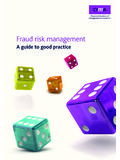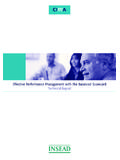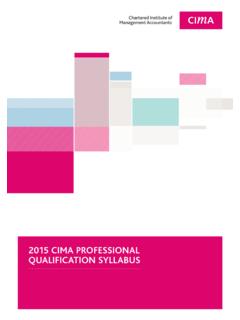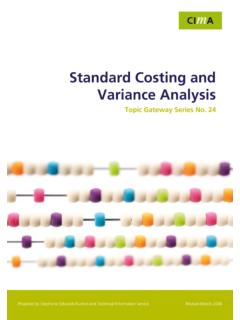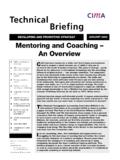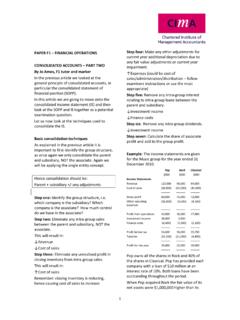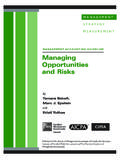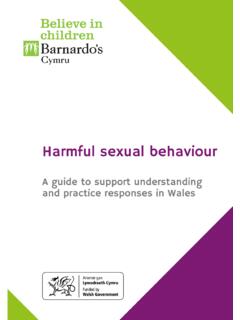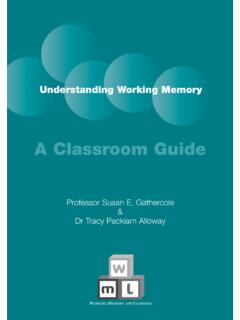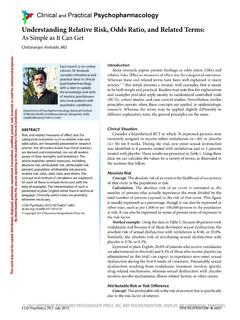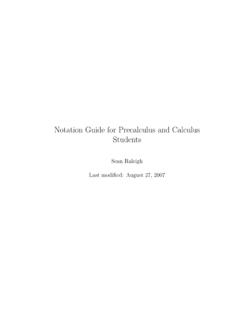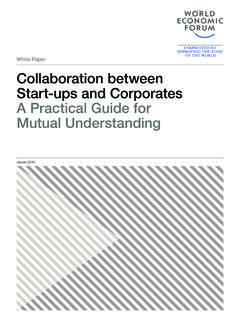Transcription of A Practitioner's Guide to the Balanced Scorecard
1 A Practitioner s Guide to the Balanced ScorecardResearch ReportA Practitioners Report Based on: Shareholder and Stakeholder Approaches to StrategicPerformance Measurement Using the Balanced Scorecard ByAllan MackayCopyright. No part of this publication may be reproduced,stored in a retrieval system, or transmitted in any form or byany means, electronic, mechanical, photocopying, recordingor otherwise, without the prior permission of makes no representation and gives no warranty as tothe accuracy of the information contained herein and doesnot accept any responsibility for any errors or inaccuracies inor omissions from this document (whether negligent orotherwise) and IIBFS shall not be liable for any loss ordamage howsoever arising as a result of any person acting orrefraining from acting in reliance on any informationcontained herein. No reader should rely on this document asit does not purport to be comprehensive or to render disclaimer does not purport to exclude any warrantiesimplied by law that may not be lawfully Practitioner s Guide to the Balanced Scorecard1 AcknowledgementsThis Guide has its foundations in theresearch, Shareholder and StakeholderApproaches to Strategic PerformanceMeasurement Using the BalancedScorecard conducted for The CharteredInstitute of Management AccountantsResearch Foundation* by theInternational Institute of Banking andFinancial Services (IIBFS) at LeedsUniversity.
2 In preparing this text I havedrawn heavily on this research. My rolehas been that of both editor and authorand I hope that in preparing the text Ihave not detracted from the valuablecontribution of the original has been impossible to compile thePractitioner s Guide without usingsignificant elements of the original textand full recognition for this importantwork is rightly due to the originalresearchers, predominantly PhilAisthorpe. His scholarly contributionmade this Guide possible and much ofhis original work is incorporated intothe Guide . He was ably supported andmentored by Professor Kevin Keasey, DrHelen Short, Robert Hudson, KevinLittler and Jose Perez Vazquez. They arealso owed a debt of gratitude. My workhas also benefited from the guidance ofProfessor Kevin Keasey and the patientproof reading and suggestions fromKevin Littler. Dr Phil Barden of TheCentre for Performance Managementand Innovation assisted me to enterthis field and has provided a valuableoverview of emerging developmentsthroughout the 2004* The Chartered Institute of ManagementAccountants Research Foundation has sincebeen subsumed into the General CharitableTrust of the Chartered Institute ofManagement AccountantsOctober 2004 Preface.
3 2 Introduction.. 41. The History and Development of the Scorecard .. 82. The Balanced Scorecard Explained.. 113. Scorecard Foundations.. 204. Building a Balanced Scorecard .. 225. Communication, Action, Presentation & Feedback.. 316. Stakeholder Balanced Scorecards: Examples from the Public Sector.. 347. Common Threads and Conclusions.. 44 Appendices.. 47 Appendix Research Process .. 47 Appendix Study 1 English Nature .. 49 Appendix Study 2 Mersey Travel .. 55 References.. 60 ContentsA Practitioner s Guide to the Balanced Scorecard2 Kaplan and Norton s Balanced Scorecard is a concept stillwidely used and respected in today s business follows, provides guidance and advice on thedevelopment and implementation of a Balanced Scorecardfor those organisations considering the introduction of aScorecard or those that have adopted the approach withlimited success. It is applicable for both public andcommercial Practitioner s Guide was written as part of a projectreceiving financial support from the Chartered Institute ofManagement Accountants Research Foundation.
4 The projectinvolved reviewing the current academic literature, followedby a telephone survey in which 460 major UK organisations,embracing both the public and commercial sectors, telephone survey was the catalyst for a focused postalquestionnaire survey of 60 of the organisations developingperformance measurement systems. After the telephonesurvey semi-structured interviews were conducted in 45 ofthe organisations. Finally, a detailed investigation on a casestudy basis was carried out at each of ten major , the majority of organisations, particularly thosein the private sector, have relied on financial and costaccounting measures to assess their performance. Financialmeasures continue to be of fundamental importance toorganisations. However, there is a growing awareness that ifan organisation is going to succeed in the contemporarybusiness and political environment, it will have to generateand take account of a wider range of measures, reflecting therequirements of customers, shareholders, employees, and thecommunities around financial and cost accounting measures recordwhat has happened in a previous period and are oftenreferred to as lag indicators.
5 Relying solely on this type ofindicator has been likened to steering a ship by its wake or driving a car viewing the route through the rear viewmirrors . In the early 1990s there was a growing awarenessthat organisations needed a wider set of measures,compatible with their increasingly complex operatingenvironments and this was the catalyst that spurred Kaplanand Norton (1991) to develop the Balanced original Kaplan and Norton model illustrated leading andlagging indicators in four different perspectives: Financial;Customer; Internal Processes; and Learning and Growth. AsKaplan and Norton state: The name reflected the balance provided between shortand long term objectives, between financial and non-financial measures, between lagging and leading indicators,and between external and internal performanceperspectives .One of the major strengths of the Balanced Scorecard is itsadaptability. Indeed, the originators make it clear that theirfour quadrants are only a template.
6 Although the term, Balanced Scorecard , might conjure up an initial impression ofa table of measurements or key performance indicators, it isin fact a process comprising of a number of carefully inter-linked steps. The real power of a properly developed BalancedScorecard is that it links the performance measures to theorganisation s strategy. Organisations implementing aScorecard process are forced to think clearly about theirpurpose or mission; their strategy and who the stakeholdersin their organisation are and what their requirements mightbe. They also need to evaluate quite clearly the time scales inwhich they hope to achieve their strategic Balanced Scorecard process involves bringing togetherthe key members of an organisation to debate and reach aconsensus on the purpose of the organisation, therequirements of its stakeholders and its strategy. By doing so,it moves beyond being a performance measurement tool toalso being a useful aid to strategic of the early adopters of the system were either largecommercial operations in the USA, or organisations withstrong American links.
7 Consequently, much of the quiteextensive management literature tended to be US-centricand weighted towards commercial research undertaken for The Chartered Institute ofManagement Accountant Research Foundation (CIMA) by TheInternational Institute of Banking and Financial Services(IIBFS) was therefore specifically designed to provide aninsight to management on the application of the BalancedScorecard process based on the experience of UKorganisations. The research also focused on the veryimportant issue of stakeholder participation. The findings ofthe research indicated increasing stakeholder participation inthe Scorecard process within the public sector. Indeed, theresearch highlighted how the Scorecard could embrace theUK Government s policies such as the Best Value Regime with its requirements to Challenge, Compare, Consult,Compete and Collaborate .Preface The Introductionto the guidebook describes the researchcarried out and details Balanced Scorecard utilisation in UKorganisations.
8 Chapter 1deals with the history and development of theBalanced Scorecard and the contextual setting of theScorecard relative to other common performancemanagement and measurement systems. Chapter 2is particularly aimed at the reader who isencountering the Scorecard for the first time and providesa detailed explanation of the major components of aBalanced Scorecard process. Chapter 3describes the foundations to a cohesive andcoherent Balanced Scorecard process and highlights thefundamental questions that the organisation mustconsider. Chapter 4reviews various design and implementationissues and draws heavily on the case studies that formedpart of the research conducted by IIBFS, to outline aframework for developing a Scorecard in a commercialorganisation. Chapter 5describes the critical issues of launching andcommunicating the Balanced Scorecard to the members ofthe organisation and to external stakeholders.
9 It also completes the circle by describing the feedback systemsthat allow the organisation to make refinements, and adaptto changing environments. Chapter 6fills a large gap in the existing literature byfocusing on an example of stakeholder inclusion in theBalanced Scorecard . It provides an overview of how a publicsector organisation, with a large number of stakeholders,may go about developing a Balanced Scorecard . Thischapter overlaps with many of the themes in the precedingchapters but this has been necessary to maintain acohesive structure useful for practitioner application. Ifanything, the overlaps reinforce some of the criticalrequirements for good Scorecard design in private sectororganisations. The examples in this chapter are intended tobe informative of the Scorecard approach and are notintended to reflect clinical or local authority best practice. Chapter 7highlights some of the key findings from theresearch and links them to more detailed work by BalancedScorecard experts.
10 The chapter draws conclusions from theresearch findings and identifies common threads betweenthe private and public Practitioner s Guide to the Balanced Scorecard3A Practitioner s Guide to the Balanced Scorecard4 What is a Balanced Scorecard ?Although in recent years few managers will have managed toavoid a discussion of the Balanced Scorecard , many will nothave a full understanding of the Balanced Scorecard process,how it works, what resources are required and whether itreally is a new approach to performance measurement. Thefollowing paragraphs attempt to clarify some of these the most obvious role of the Balanced Scorecard isthe Scorecard element to record and clearly illustrate thesmall number of key measurements (20-25) that allow busyexecutives to quickly evaluate what is going on in criticalareas of their organisation. However, if the BalancedScorecard is to merit its description as an innovativeapproach to performance measurement, it has to be muchmore than a scoring or results recording use of the word Balanced reflects the roots of theBalanced Scorecard in concerns that organisations weregiving too much emphasis to short term financial andbudgetary issues.
